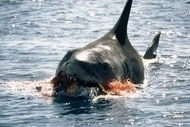Create a free profile to get unlimited access to exclusive videos, sweepstakes, and more!
This weird, winged shark once swam prehistoric seas 93 million years ago

With wings reminiscent of manta or devil rays and a broad mouth for extended plankton feeding, a new species of prehistoric eagle shark has been identifed by an international team of paleontologists led by researchers at Géosciences Rennes1 (CNRS/University of Rennes 1) in France.
Their research paper was published online last week and made the cover story for the Mar. 16 issue of Science.
This winged hybrid shark, officially named Aquilolamna milarcae (meaning eagle shark of the Milarca Museum), once prowled primeval waters roughly 93 million years ago in what is now modern Mexico, but was then covered by the Western Interior Seaway which spanned from the Gulf of Mexico to the Arctic Ocean.
The fossilized specimen measuring five-and-a-half feet long with a wingspan of over six feet was first discovered back in 2012 by a quarryman in a section of limestone rock in the northwestern Mexico state of Nuevo León. Its existence should enable scientists to create an entirely new family of eagle sharks and represents a treasure of new information on the morphological diversity and evolution of late Cretaceous sharks.
"One of the most striking features of Aquilolamna is that it has very long, slender pectoral [side] fins," lead researcher Romain Vullo, a vertebrate paleontologist with the National Center for Scientific Research (CNRS) at Geosciences Rennes, told Live Science. "This makes the shark wider than long," with a "wingspan" of about 6.2 feet (1.9 meters) and a total body length of about 5.4 feet (1.65 meters).
"Another interesting feature is that the head is short, with an indistinct snout and a wide mouth," Vullo noted. "The other parts of the Aquilolamna, such as its tail and caudal [tail] fin, are like [those] in many modern sharks. This gives to Aquilolamna a unique chimeric appearance."
Sharks, manta rays, and a variety of other fish with cartilage skeletons belong to a group called elasmobranchs, a category of animals that first came onto Earth's biological scene 380 million years ago as an example of convergent evolution, a process in which both sharks and rays evolved independently but with similar features.
"Aquilolamna was probably a relatively slow swimmer, comparable to other suspension-feeding elasmobranchs that slowly swim through the water, guzzling down plankton," the researchers indicated in the study. "Aquilolamna milarcae displays many features similar to modern manta rays, notably long, slender fins and a mouth seemingly adapted to filter feeding, suggesting that it was planktivorous."
The absence of a prominent shark-like dorsal fin or underbelly pelvic fins on Aquilolamna doesn't necessarily mean these creatures didn't sport those fins when alive and could simply infer that they never fossilized in the first place.
"This previously unknown body plan represents an unexpected evolutionary experimentation with underwater flight among sharks, more than 30 million years before the rise of manta and devil rays (Mobulidae), and shows that winglike pectoral fins have evolved independently in two distantly related clades of filter-feeding elasmobranchs," the researchers explained.
To accurately classify this odd winged shark, paleontologists could have relied on its preserved teeth, but in this case, none were found at the excavation site in Mexico.
"Identification of fossil sharks generally relies on tooth characteristics," Kenshu Shimada, a professor of paleobiology at DePaul University in Chicago told Live Science. "So, the authors of the new study tentatively placed the new fossil shark in a group called the Lamniformes based on the characteristics seen in its vertebrae and tail skeleton, which are less taxonomically diagnostic.
"This is indeed a remarkable discovery, but only the discovery of additional, well-preserved specimens, especially those with teeth, may shed light on the shark's true anatomy, as well as whether it really was a filter feeder."



























